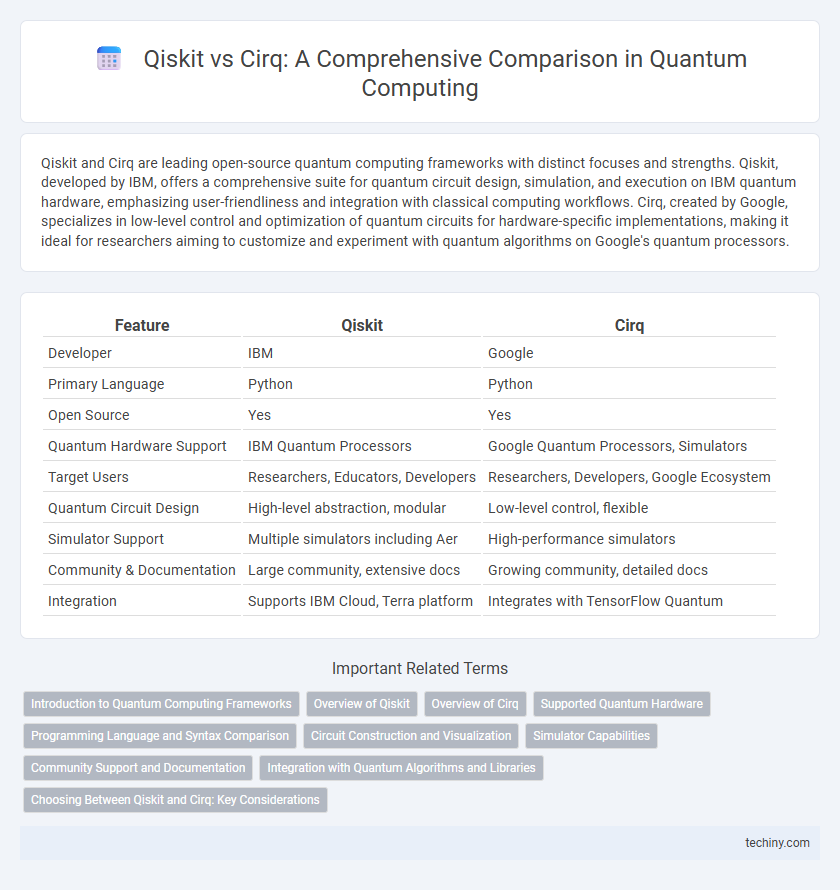Qiskit and Cirq are leading open-source quantum computing frameworks with distinct focuses and strengths. Qiskit, developed by IBM, offers a comprehensive suite for quantum circuit design, simulation, and execution on IBM quantum hardware, emphasizing user-friendliness and integration with classical computing workflows. Cirq, created by Google, specializes in low-level control and optimization of quantum circuits for hardware-specific implementations, making it ideal for researchers aiming to customize and experiment with quantum algorithms on Google's quantum processors.
Table of Comparison
| Feature | Qiskit | Cirq |
|---|---|---|
| Developer | IBM | |
| Primary Language | Python | Python |
| Open Source | Yes | Yes |
| Quantum Hardware Support | IBM Quantum Processors | Google Quantum Processors, Simulators |
| Target Users | Researchers, Educators, Developers | Researchers, Developers, Google Ecosystem |
| Quantum Circuit Design | High-level abstraction, modular | Low-level control, flexible |
| Simulator Support | Multiple simulators including Aer | High-performance simulators |
| Community & Documentation | Large community, extensive docs | Growing community, detailed docs |
| Integration | Supports IBM Cloud, Terra platform | Integrates with TensorFlow Quantum |
Introduction to Quantum Computing Frameworks
Qiskit, developed by IBM, and Cirq, created by Google, are two leading open-source quantum computing frameworks designed to facilitate quantum algorithm development and experimentation. Qiskit offers a comprehensive suite of tools with strong integration to IBM Quantum hardware, making it ideal for both beginners and advanced users seeking robust quantum circuit simulation and real-device execution. Cirq emphasizes low-level quantum circuit manipulation and optimization, tailored for Google's quantum processors, enabling researchers to design and test custom quantum gates and error mitigation techniques.
Overview of Qiskit
Qiskit is an open-source quantum computing software development framework developed by IBM, designed to facilitate the creation and execution of quantum algorithms on IBM quantum processors and simulators. It provides a comprehensive suite of tools including quantum circuit creation, optimization, and access to a variety of backend devices, supporting languages such as Python. Qiskit's modular architecture encompasses Terra for circuit building, Aer for simulation, and Ignis for noise characterization, making it a versatile platform for researchers and developers in quantum computing.
Overview of Cirq
Cirq is an open-source quantum computing framework developed by Google, designed specifically for creating, optimizing, and running quantum circuits on noisy intermediate-scale quantum (NISQ) processors. It offers fine-grained control over quantum gates and qubit operations, enabling researchers to experiment with error mitigation techniques and hardware-specific optimizations. Unlike Qiskit, Cirq emphasizes closer hardware integration and supports advanced quantum algorithms tailored for Google's quantum processors.
Supported Quantum Hardware
Qiskit supports a wide range of quantum hardware platforms, including IBM Quantum processors with different qubit architectures such as superconducting qubits and trapped ions. Cirq primarily targets Google Quantum AI's superconducting qubit processors and offers specialized tools for noise characterization and error mitigation in these devices. Both frameworks enable access to cloud-based quantum processors, but Qiskit provides broader compatibility across various quantum hardware providers.
Programming Language and Syntax Comparison
Qiskit utilizes Python with a straightforward, high-level syntax designed for ease of use in quantum circuit creation, emphasizing modularity and extensive library support. Cirq also employs Python but offers a more granular, hardware-focused syntax that allows greater control over low-level gate operations and noise modeling for NISQ devices. While Qiskit is tailored for IBM Quantum systems, Cirq is optimized for Google's quantum processors, reflected in their respective programming paradigms and syntax structures.
Circuit Construction and Visualization
Qiskit offers a comprehensive circuit construction framework with a high-level, user-friendly API that supports intuitive quantum gate assembly and extensive visualization tools, including circuit diagrams and real-time state visualization. Cirq provides fine-grained control with low-level circuit building capabilities tailored for Google's quantum processors, emphasizing modularity and interoperability, along with customizable visual outputs for complex quantum circuits. Both frameworks enable detailed quantum circuit design, but Qiskit excels in user-oriented visualization while Cirq caters to experimental flexibility and bespoke circuit representation.
Simulator Capabilities
Qiskit offers robust simulator capabilities including the Aer simulator that supports noise models, multi-qubit statevector simulation, and pulse-level control ideal for testing quantum algorithms on classical hardware. Cirq features simulators optimized for Google's quantum processors, such as the Density Matrix Simulator for noisy intermediate-scale quantum (NISQ) devices and a Clifford simulator for specific circuit types. Qiskit's extensive noise modeling and pulse simulation make it suitable for detailed quantum error analysis, while Cirq excels in scalability and integration with Google's Sycamore architecture.
Community Support and Documentation
Qiskit offers extensive community support with a large, active user base and comprehensive documentation including tutorials, API references, and forums maintained by IBM. Cirq, developed by Google, provides detailed documentation and strong developer engagement through GitHub and Google's quantum computing community, though its user base is smaller compared to Qiskit. The breadth of Qiskit's resources and its collaborative channels make it more accessible for beginners and researchers seeking robust community interaction.
Integration with Quantum Algorithms and Libraries
Qiskit offers seamless integration with IBM's quantum algorithms and extensive libraries, providing robust tools for error mitigation and circuit optimization that enhance algorithm performance. Cirq, designed by Google, emphasizes flexibility in algorithm design and is tightly integrated with TensorFlow Quantum, enabling hybrid quantum-classical machine learning workflows. Both platforms support advanced quantum algorithm development but cater to different ecosystems, with Qiskit excelling in hardware accessibility and Cirq specializing in near-term quantum device simulation and machine learning integration.
Choosing Between Qiskit and Cirq: Key Considerations
Qiskit, developed by IBM, offers robust support for quantum algorithms and seamless integration with IBM Quantum hardware, making it ideal for users focused on practical experimentation and extensive documentation. Cirq, created by Google, emphasizes low-level control and customizability for NISQ devices, appealing to researchers targeting advanced quantum circuit design and simulation. Key considerations when choosing between Qiskit and Cirq include hardware compatibility, user community size, ease of use, and specific research or development goals in quantum algorithm implementation.
Qiskit vs Cirq Infographic

 techiny.com
techiny.com